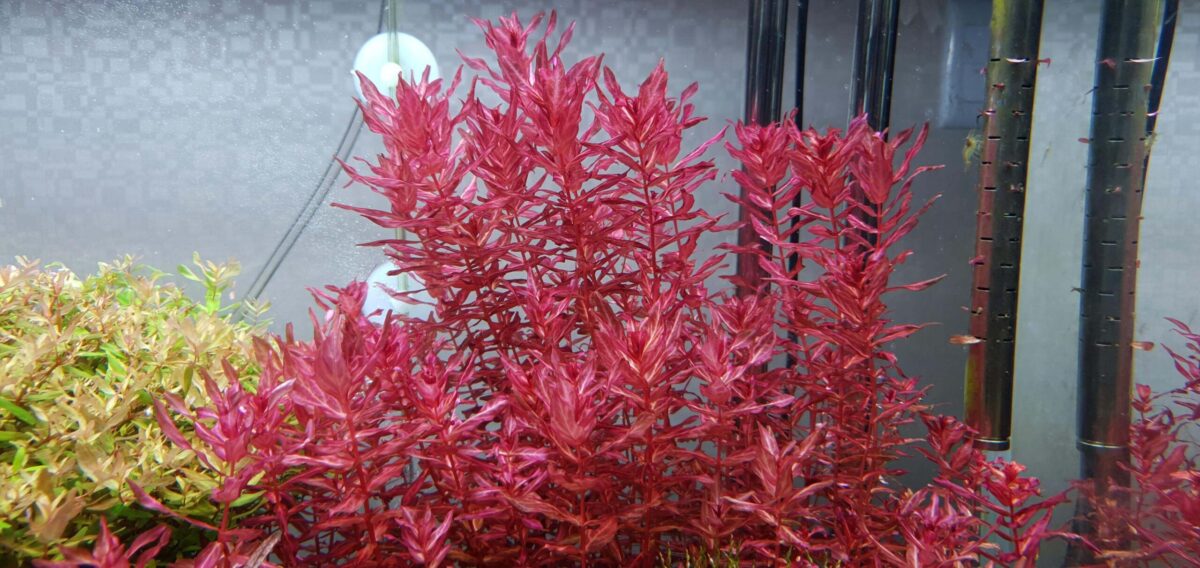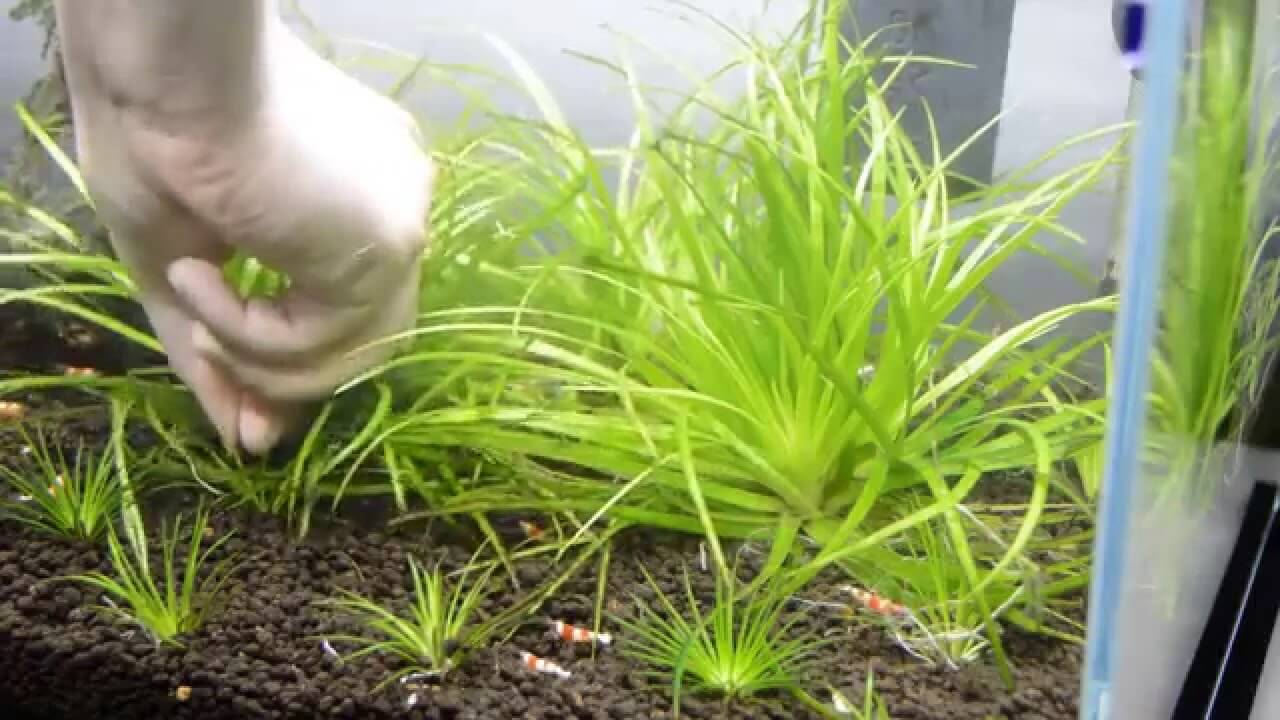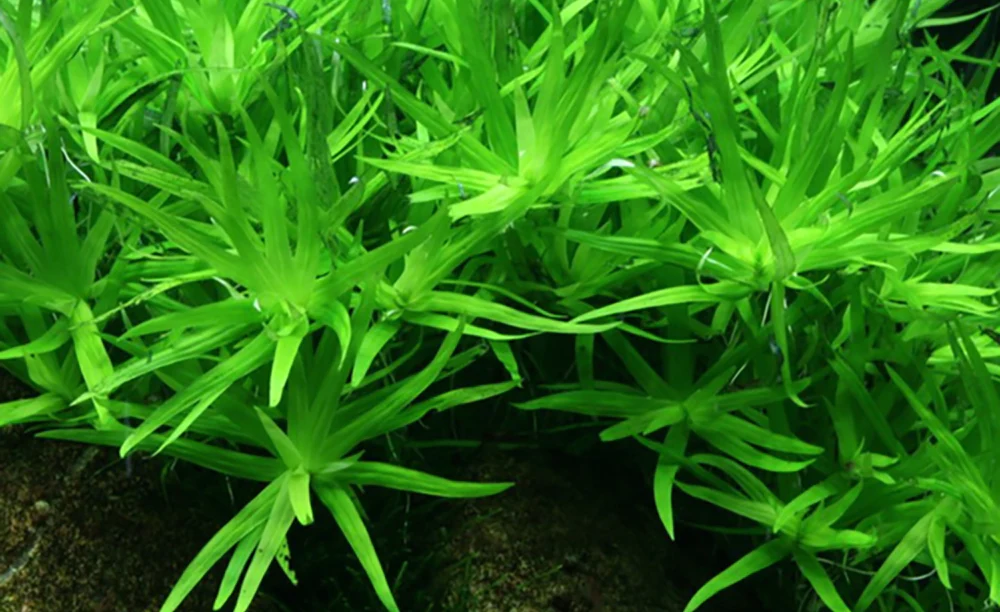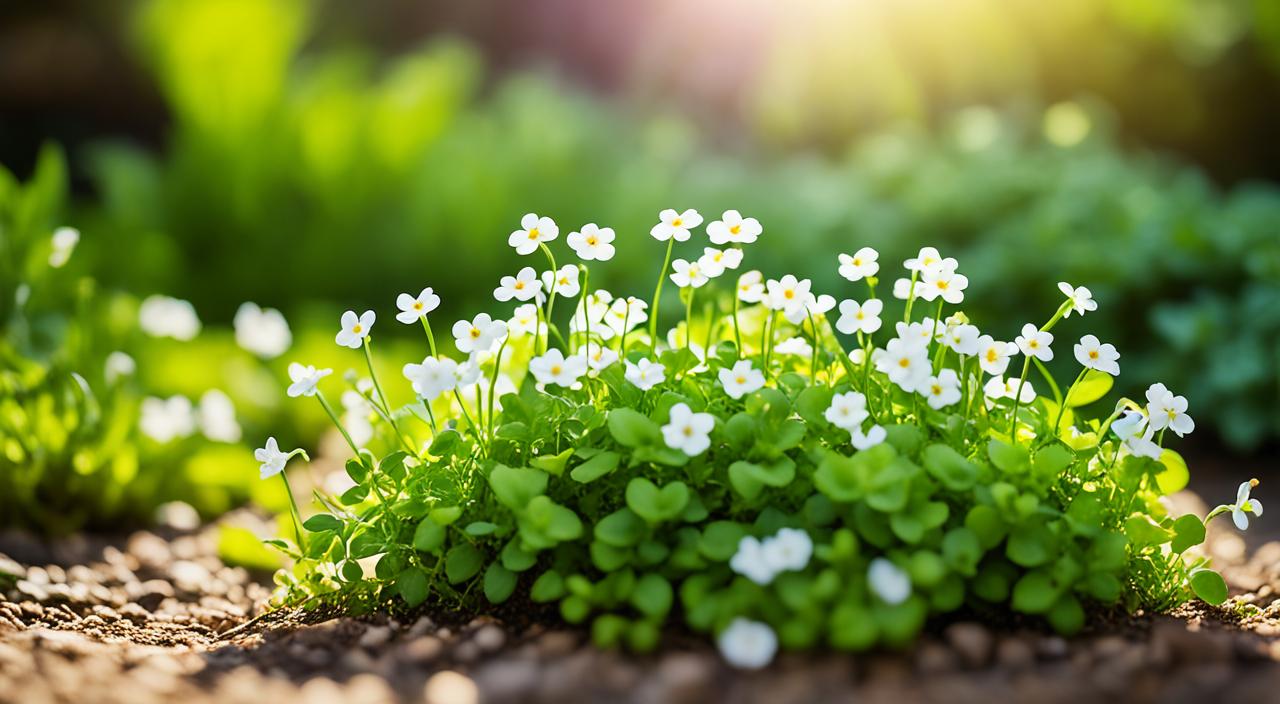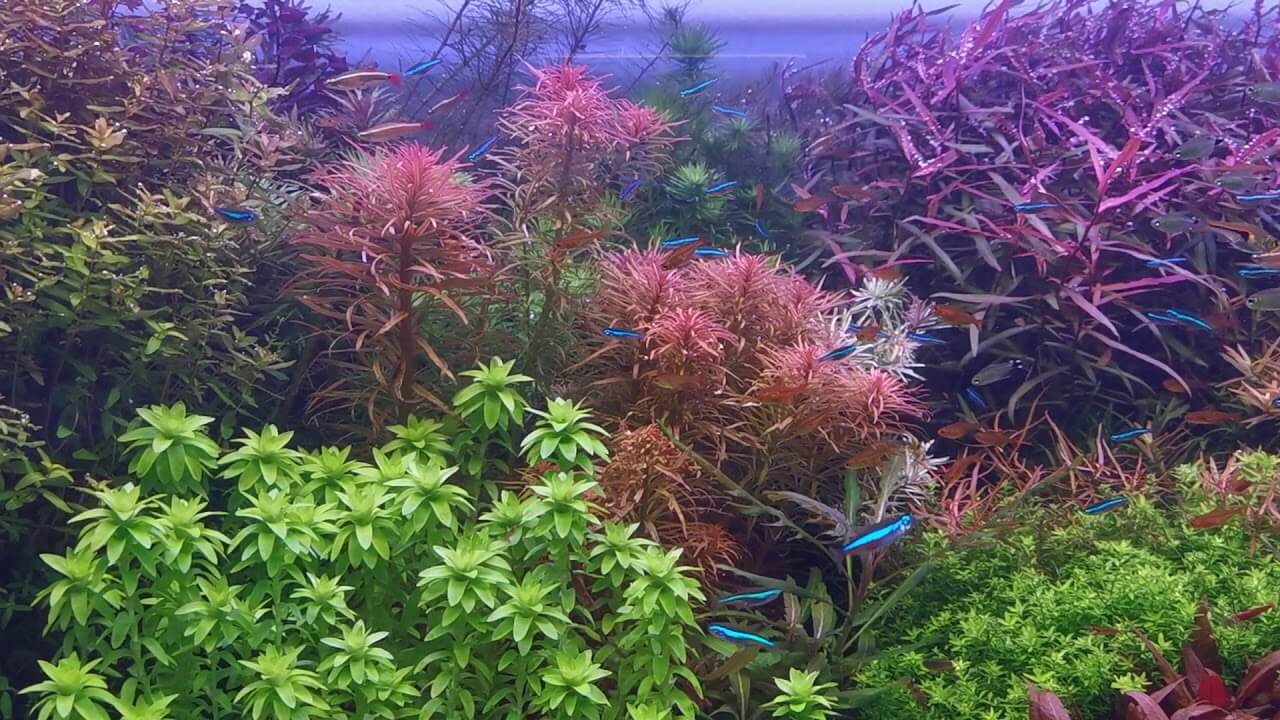Greetings, fellow aquarium enthusiasts! Today, I want to share valuable insights and tips on caring for Rotala macrandra red variegated, a stunning aquatic plant that will bring a vibrant burst of colour to your high-light aquarium. With its captivating red and pink veins, this plant is a true showstopper that deserves a place of honour in your aquascape.
Rotala macrandra red variegated, known as Rotála macrándra Koehne in the botanical world, belongs to the Lythraceae family. Growing this plant can be a rewarding and visually striking experience, but it does require specific care to thrive in your aquatic environment.
First and foremost, let’s talk about the lighting requirements. Rotala macrandra red variegated is considered a high-light species, which means it needs intense lighting to flourish. You’ll want to provide your aquarium with T5HO or LED lights to meet its light demands, ensuring a PAR value of at least 100 or higher. This will allow the plant to undergo optimal photosynthesis and showcase its vibrant colours in all its glory.
Regarding water conditions, Rotala macrandra red variegated prefers a pH range of 4-7 and a temperature tolerance between 18-30°C. It thrives best in a well-maintained planted tank, so regular water testing and appropriate filtration are essential. Additionally, it would be best to consider supplementing your tank with CO2 to promote healthy growth and vibrant colouration.
Propagation of Rotala macrandra red variegated can be achieved through cuttings. Snip a healthy stem and replant it in a fresh substrate. With proper care and maintenance, you’ll be delighted to see new shoots sprouting from the base.
To ensure the overall health of your aquatic ecosystem, choosing suitable tank mates for Rotala macrandra red variegated is essential. Small to medium-sized fish, such as tetras, rasboras, guppies, and peaceful dwarf cichlids, make great companions for this delicate plant. However, be cautious of larger or more aggressive species that may damage the plant or consume its leaves.
Key Takeaways:
- Rotala macrandra red variegated is a standout aquatic plant known for its vibrant red and pink veins.
- It requires high light conditions, with a recommended PAR value of at least 100 or higher.
- Maintaining water parameters such as pH 4-7 and temperature 18-30°C is crucial for its health.
- Consider supplementing your tank with CO2 to promote healthy growth and colour development.
- When choosing tank mates, opt for small to medium-sized fish that won’t disturb the plant’s delicate leaves.
Brief Overview Of Rotala macrandra red variegated
Rotala macrandra red variegated is a stunning aquatic plant that adds vibrant colour to advanced aquascapes. Its striking red and pink veins stand out against the darker leaf tissue, creating a visually spectacular effect. This plant proliferates and can be used as an accent plant in aquascaping designs. It is a medium-difficulty plant and requires specific care to thrive. It can create a stunning focal point in any aquarium with the right conditions.
This plant variety, commonly called “red variegated,” is highly sought by advanced aquarists and aquarium enthusiasts. Its distinct colours and unique leaf pattern make it famous for creating eye-catching aquascapes.
Rotala Macrandra Red Variegated Table:
| Row Names | Descriptions |
|---|---|
| Scientific Name: | Rotala macrandra ‘Red Variegated’ |
| Common Names: | Variegated Rotala, Red Rotala |
| Origin: | India |
| Height: | Up to 50 cm (20 inches) |
| Growth Rate: | Fast |
| Colour: | Red with variegated patterns |
| Aquarium Placement: | Midground to Background |
| Water Type: | Freshwater |
| pH: | 5.0 – 7.5 |
| Care Level: | High |
| Light Requirements: | High; 50-70 PAR (Photosynthetically Active Radiation), 6500-7000 Kelvin, 30-50 LUX |
| CO2 Requirements: | High |
| Temperature: | 22-28°C (72-82°F) |
| Flow Rate: | Moderate to High |
| Propagation: | Cuttings |
| Feed Type: | Liquid fertilizers, CO2 supplementation |
Expanded Light Requirements:
For Rotala macrandra ‘Red Variegated’, achieving vibrant colouration and optimal growth requires high lighting conditions. Specifically, it thrives under a PAR (Photosynthetically Active Radiation) value of 50-70, which indicates intense light that effectively supports photosynthesis. The ideal Kelvin scale for the light source should be between 6500-7000K, which mimics natural daylight and promotes healthy growth and colour development. Additionally, aiming for a light intensity of about 30-50 LUX can further ensure the plant receives adequate light without exposure to excessive brightness that could cause stress or bleaching. Adjusting these lighting parameters and proper CO2 and nutrient supplementation can significantly enhance the plant’s growth and aesthetic appeal in an aquascape.
Rotala macrandra red variegated is part of the Lythraceae family and has the botanical name Rotala macrandra Koehne. It is known for its fast growth and the ability to propagate through cuttings. This plant can thrive both submerged and emersed, making it a versatile choice for different aquarium setups.
As a medium-difficulty plant, Rotala macrandra red variegated requires specific care and maintenance to ensure optimal growth. It thrives in high-light conditions and benefits from the supplementation of CO2 and appropriate fertilization. Providing the correct water parameters, substrate, and tank placement, are critical factors supporting the plant’s health and development.
In aquascaping, Rotala macrandra red variegated is often used as a background or midground plant to create a vibrant and visually appealing focal point. When correctly cared for and maintained, this plant can transform an aquarium into a lush and captivating underwater landscape.
Origins And Habitat
Rotala macrandra is native to India and has been cultivated in aquariums for many years. It is commonly found in the aquatic habitats of India and thrives in the warm climates of the region. It is often found growing in slow-moving or stagnant waters, such as ponds, lakes, and marshes. It grows submerged in its natural habitat but can also adapt to emersed growth when conditions are suitable.
Morphological Characteristics
Rotala macrandra is known for its large, delicate leaves that can vary in shape depending on the specific varietal. The leaves can be narrow or broad, and some varietals have unique curled or serrated leaf edges. The plant can grow tall and bushy, creating a dense and vibrant display. Its colouration ranges from deep red to light pink, with contrasting veins that add to its visual appeal.
| Leaf Shape | Growth Form |
|---|---|
| Narrow or broad | Tall and bushy |
| Curled or serrated edges | Dense and vibrant |
| Colouration: deep red to light pink | Contrasting veins |
Placement And Lighting
Rotala macrandra red variegated is a high-light aquarium plant that requires intense lighting to thrive. It is best placed in the background or midground of an aquarium to showcase its vibrant colours. To ensure proper growth and colour development, it is essential to provide the plant with adequate lighting. This can be achieved using lighting options such as T5HO or LED lights, which deliver the necessary intensity. It is recommended to provide a PAR (Photosynthetically Active Radiation) value of at least 100 or higher for optimal growth.
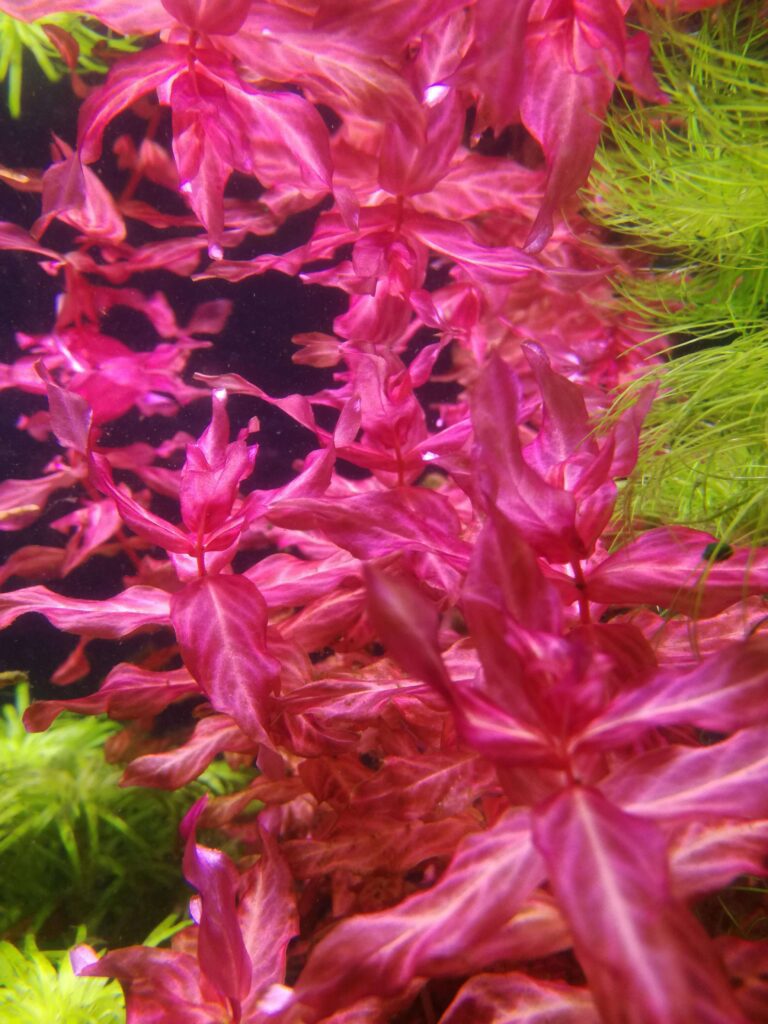
Proper placement and lighting are crucial factors in creating a visually stunning aquascape with Rotala macrandra red variegated. By providing the plant with the right conditions, you can showcase its beauty and create an eye-catching centerpiece for your aquarium.
What Are Good Tank Mates?
Good Tank Mates
Rotala macrandra red variegated can coexist harmoniously with various fish species in a community aquarium. Choosing small to medium-sized fish that do not threaten the plant’s delicate leaves is advisable. Some ideal tank mates for Rotala macrandra include tetras, such as neon tetras and cardinal tetras, rasboras, such as harlequin rasboras and espei rasboras, guppies, and peaceful dwarf cichlids like apistogrammas and rams. These fish species are known for their calm temperament and are less likely to damage the plant or consume its leaves. They will coexist comfortably, enhancing the aesthetics and diversity of your aquarium.
Fish Species To Avoid
While Rotala macrandra red variegated can thrive alongside many fish species, avoiding larger, aggressive fish that may risk the plant’s well-being is crucial. Aggressive fish can damage the delicate leaves of Rotala macrandra or even consume them entirely, inhibiting the plant’s growth. Therefore, avoiding species such as large cichlids, aggressive barbs, and territorial fish like bettas is best. Always research the specific requirements and temperament of potential tank mates before introducing them to your aquarium to ensure a peaceful and compatible environment for Rotala macrandra red variegated.
Feeding (Fertilization)
How Much And How Often To Feed
Rotala macrandra red variegated requires regular fertilization to thrive. To ensure the plant’s nutrient requirements are met, it is recommended to provide a balanced fertilizer that includes macronutrients such as nitrogen, phosphorus, and potassium, as well as micronutrients like iron and trace elements.
The exact dosage of fertilizer will depend on the specific tank conditions and the plant’s needs. A weekly dosage of 1-2 ppm of nitrogen, 0.5-1 ppm of phosphorus, and 10-20 ppm of potassium is recommended as a general guideline. It is essential to closely monitor the plant’s response to the fertilizer and adjust the dosage accordingly.
When feeding the plant, following the manufacturer’s instructions on the fertilizer packaging is advised. This will ensure the plant receives the right nutrients without risking overfertilization. Regular water testing can also help determine the nutrient levels in the aquarium and guide the feeding schedule for Rotala macrandra red variegated.
This vibrant plant can thrive and continue to add beauty to your aquarium by providing the appropriate fertilisation.
CO2 Injection
Types
CO2 injection is crucial in the optimal growth of Rotala macrandra red variegated. It helps maintain stable CO2 levels in the aquarium, which is essential for the plant’s photosynthesis process. There are various methods of CO2 injection that aquarists can choose from, depending on their tank size, budget, and personal preference.
1. CO2 Gas Cylinder with Regulator
Using a CO2 gas cylinder with a regulator is popular among aquascapers. It involves connecting a CO2 gas cylinder to a regulator, allowing precise control of CO2 dosing in the aquarium. This method provides a steady and consistent supply of CO2, ensuring the plants receive adequate carbon dioxide for photosynthesis.
2. DIY Yeast CO2 System
A DIY yeast CO2 system is a cost-effective alternative for those on a budget. Mixing yeast, sugar, and water in a homemade reactor or bottle. As the yeast consumes the sugar, it produces CO2, which is released into the aquarium. While this method is affordable, it may be more challenging to regulate and maintain consistent CO2 levels compared to a gas cylinder system.
3. Liquid Carbon Supplements
Another option for CO2 supplementation is the use of liquid carbon supplements. These products contain liquid carbon compounds that can be easily added to the aquarium. While they provide a carbon source for the plants, they may not be as effective as CO2 gas injection systems. Liquid carbon supplements are often used as an alternative for low-tech or low-light setups where CO2 injection is not necessary or feasible.
Each CO2 injection method has advantages and disadvantages, and aquarists should consider their requirements and preferences when choosing the most suitable option for their aquascape. It’s essential to maintain optimal CO2 levels to ensure the healthy and vigorous growth of Rotala macrandra red variegated.
| CO2 Injection Method | Pros | Cons |
|---|---|---|
| CO2 Gas Cylinder with Regulator | Precise control of CO2 dosing Steady and consistent CO2 supply | Higher initial cost Requires CO2 gas cylinder setup |
| DIY Yeast CO2 System | Cost-effective Suitable for small setups | Challenging to regulate CO2 levels Requires frequent maintenance |
| Liquid Carbon Supplements | Easy to use No additional setup required | Less effective than CO2 gas injection Potential variations in effectiveness |
Care
Planted Tank Parameters
Proper care is essential for the healthy growth of Rotala macrandra red variegated. Specific parameters must be maintained in the planted tank to create an ideal environment for this plant. The pH level should range between 4 and 7, providing slightly acidic conditions. The temperature should be kept within the 18-30°C range, ensuring a suitable climate for the plant’s growth. These parameters mimic the natural habitat of Rotala macrandra and promote optimal health.
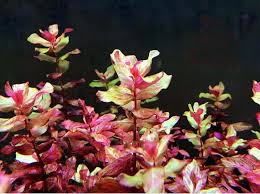
Water Quality
Monitoring water quality is crucial to caring for Rotala macrandra red variegated. Regular water changes should be performed to maintain favourable conditions. This ensures the water is free from accumulated pollutants and maintains the necessary nutrient levels for the plant’s growth. Additionally, it is essential to test the water parameters regularly to ensure they remain within the appropriate range for the plant’s well-being.
Filtration
Filtration is vital in maintaining a healthy environment for Rotala macrandra red variegated. A quality filtration system helps keep the water clean and free from debris that could negatively impact the plant’s growth. It removes excess waste, uneaten food, and other harmful substances that can accumulate in the tank. A properly functioning filtration system ensures that the water remains clear and provides a suitable habitat for the plant.
Flow
In addition to filtration, creating the proper flow within the tank is crucial for the optimal Rotala macrandra red variegated growth. A moderate to high flow rate is recommended to ensure adequate circulation and nutrient distribution throughout the tank. This helps deliver essential nutrients to the plant’s roots and prevents stagnant water conditions that can lead to algae growth and poor oxygenation. A well-regulated flow helps create an environment that supports the overall health and vitality of the plant.
Aquarium Maintenance
Testing Water Conditions
Regularly testing the water conditions is essential for properly maintaining your Rotala macrandra red-variegated aquarium. Testing the water parameters allows you to ensure that they are within the appropriate range for the plant’s growth and overall health.
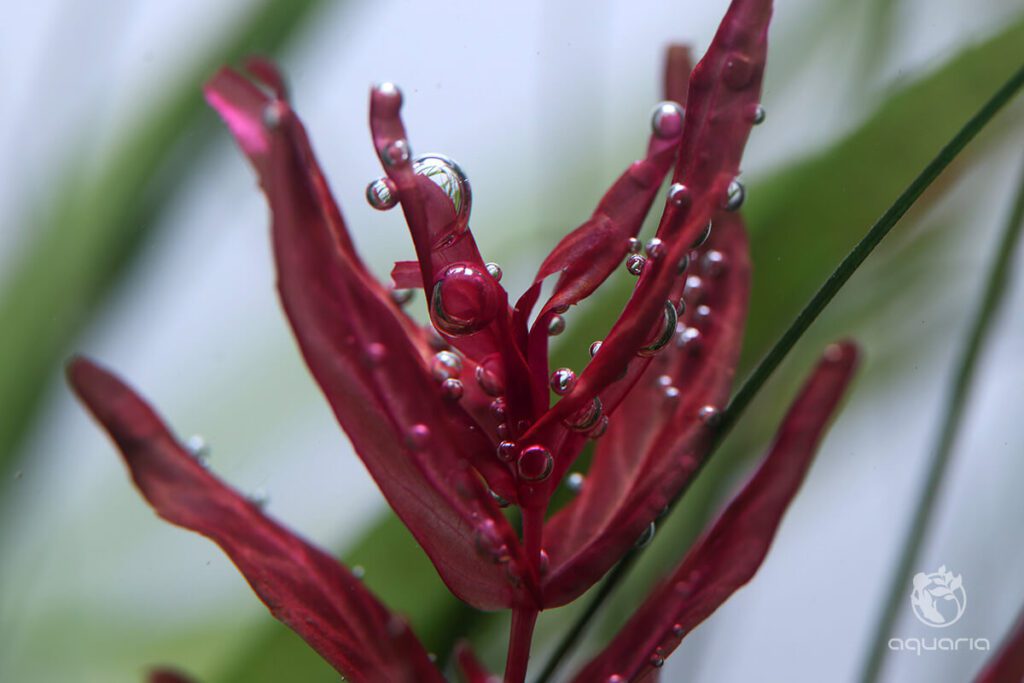
Aquarium water testing kits are readily available and accurately measure various parameters such as pH, ammonia, nitrite, nitrate, and phosphate levels. It is recommended to test your water at least once a week to monitor any fluctuations and take necessary actions.
How To Set Up Your Aquarium Tank
Properly setting up your aquarium tank is crucial for creating a suitable environment for your Rotala macrandra red variegated. Here are the key steps to follow:
- Substrate: Choose a nutrient-rich substrate designed explicitly for planted aquariums. This will provide essential nutrients for the plant’s growth.
- Lighting: Use high-quality aquarium lights that provide adequate intensity and spectrum for your plants. LED lights are commonly recommended for planted aquariums.
- Filtration: Install an efficient filtration system to maintain water quality and circulation. This will help remove waste and prevent the build-up of harmful substances.
- CO2 Injection: Consider supplementing CO2 to ensure optimal plant growth. This can be done using a CO2 system or liquid carbon supplements.
- Plant Placement: Arrange your Rotala macrandra red variegated in the background or midground of your tank to showcase its vibrant colours.
Propagation Methods
Propagating Rotala macrandra red variegated is a great way to expand your collection or replace aging stems. The most common propagation method for this plant is through stem cuttings. Here’s how:
- Identify a healthy stem with several nodes.
- Use sharp scissors or aquarium plant trimming tools to make a clean cut below a node.
- Remove the lower leaves from the cutting, leaving only a few leaves at the top.
- Plant the cutting in the substrate, making sure it is securely anchored.
- Provide the new cutting with the same care and conditions as the parent plant.
- The cutting will develop roots within a few weeks and grow new shoots.
Regularly monitor the new cuttings and ensure they receive proper light, CO2, and nutrient fertilization.
Water Parameters for Rotala macrandra red variegated
| Parameter | Ideal Range |
|---|---|
| pH | 4.0 – 7.0 |
| Temperature | 18°C – 30°C |
| Lighting | High intensity (T5HO or LED) |
| CO2 | Supplemented (recommended) |
| Fertilization | Regular dosing of macros and micros |
| Water Flow | Moderate to high |
Health And Disease
Monitoring the health of Rotala macrandra red variegated is essential to ensure its well-being. Signs of good health include vibrant colouration, robust growth, and dense foliage. On the other hand, signs of poor health may consist of yellowing leaves, stunted growth, or leaf deterioration. Common health issues affecting the plant include nutrient deficiencies, algae overgrowth, and pests such as snails or aphids. It is essential to address any health issues promptly by adjusting the tank conditions, providing proper fertilization, and implementing appropriate pest control methods.
Signs Of Good Health
Healthy Rotala macrandra red variegated exhibits vibrant colouration, showcasing rich shades of red and pink. The plant shows robust growth, with new shoots sprouting regularly. The foliage is dense and lush, creating an eye-catching display in the aquarium.
Signs Of Poor Health
When Rotala macrandra red variegated is in poor health, the leaves may turn yellow or show signs of discolouration. The plant’s growth may become stunted, with limited new growth or withering shoots. Leaf deterioration, including holes or browning, can also indicate poor health.
Common Health Issues And Treatment
Several common health issues can affect Rotala macrandra red variegated. Nutrient deficiencies, such as iron or potassium, can lead to poor growth and faded colouration. Algae overgrowth can block light and hinder the plant’s growth. If plant pests like snails or aphids are present, they can damage the leaves and disrupt the plant’s health.
Treating these health issues involves adjusting the tank conditions to provide nutrients and light levels. Fertilization with a balanced fertilizer can address nutrient deficiencies while controlling light intensity and duration, which can help combat algae overgrowth. Manual removal or appropriate plant pest control methods can effectively eliminate plant pests.
Plant Pests
Plant pests can significantly threaten the health of Rotala macrandra red variegated. Common plant pests that may affect this aquatic plant include snails and aphids. Snails can chew on the leaves, leaving visible marks and damaging the plant’s health. Aphids, on the other hand, suck sap from the leaves, causing distortion and weakening.
Controlling plant pests involves manual removal or the use of appropriate pest control methods. For snails, physically removing them from the aquarium or using snail traps can help reduce their population. For aphids, introducing natural predators or using organic insecticides can effectively control their numbers and minimize damage to the plant.
Summary
After exploring the various aspects of Rotala macrandra red variegated care, it is clear that this stunning high-light aquarium plant requires specific attention and care to thrive. Its vibrant colours and unique leaf pattern make it an excellent choice for advanced aquascapes, adding a focal point of visual interest to any aquarium.
Proper lighting is crucial to ensure the optimal growth and overall health of Rotala macrandra red variegated. Providing the plant with adequate light intensity, such as T5HO or LED lights, will allow it to reach its full potential. Additionally, CO2 supplementation is highly recommended to maintain stable carbon dioxide levels, facilitating photosynthesis and supporting optimal growth.
Nutrient fertilization is another critical factor in Rotala macrandra red variegated care. A balanced fertilizer that includes macro and micronutrients should be provided to meet the plant’s requirements. Regular monitoring of water conditions and adjustment of fertilization based on the plant’s response is essential for its overall health and well-being.
Lastly, regular maintenance, including water testing and monitoring, is vital to ensure the long-term success of this beautiful aquatic plant. By maintaining suitable water parameters, implementing proper tank set-up, and addressing any health issues promptly, Rotala macrandra red variegated can thrive and become a stunning addition to any aquascape.
FAQ
What is Rotala macrandra red variegated?
Rotala macrandra red variegated is a stunning aquatic plant known for its vibrant red and pink veins, adding a colorful touch to advanced aquascapes.
What are the care requirements for Rotala macrandra red variegated?
Rotala macrandra red variegated requires high light levels, CO2 supplementation, and regular fertilization to thrive. It also prefers a pH range of 4-7 and a temperature of 18-30°C.
Where is Rotala macrandra red variegated native to?
Rotala macrandra red variegated is native to India and is commonly found in the aquatic habitats of the region, such as ponds, lakes, and marshes.
What are the morphological characteristics of Rotala macrandra red variegated?
Rotala macrandra red variegated has large, delicate leaves with varying shapes, from narrow to broad. It displays a range of colors, from deep red to light pink, with striking veins.
Where should I place Rotala macrandra red variegated in my aquarium?
Rotala macrandra red variegated is best placed in the background or midground of an aquarium to showcase its vibrant colors and unique leaf pattern.
What are suitable tank mates for Rotala macrandra red variegated?
Suitable tank mates include small to medium-sized fish, such as tetras, rasboras, guppies, and peaceful dwarf cichlids. It is important to avoid larger, aggressive fish species that may damage the plant.
How should I fertilize Rotala macrandra red variegated?
Regular fertilization is necessary for the healthy growth of Rotala macrandra red variegated. A balanced fertilizer with macros (nitrogen, phosphorus, potassium) and micros (iron, trace elements) should be provided according to the manufacturer’s instructions.
Is CO2 injection necessary for Rotala macrandra red variegated?
Yes, CO2 injection is highly recommended for the optimal growth of Rotala macrandra red variegated. Stable CO2 levels are crucial for the plant’s photosynthesis process.
What are the tank parameters required for Rotala macrandra red variegated?
Rotala macrandra red variegated prefers a pH range of 4-7 and a temperature of 18-30°C. Water quality should be monitored, and regular water changes should be performed. Proper filtration and moderate to high flow are recommended.
How do I maintain a Rotala macrandra red variegated aquarium?
Regular aquarium maintenance includes testing water conditions, setting up the aquarium correctly, and propagating the plant through cuttings. Monitoring plant health and addressing any issues promptly is also important.
What are common health issues of Rotala macrandra red variegated?
Nutrient deficiencies, algae overgrowth, and plant pests such as snails or aphids are common health issues that can affect Rotala macrandra red variegated. Prompt action and proper treatment should be taken to address these issues.
How can I summary the care for Rotala macrandra red variegated?
Rotala macrandra red variegated requires high light, CO2 supplementation, proper fertilization, and specific tank parameters to thrive. Regular maintenance and monitoring are essential for its health and longevity in the aquarium.

